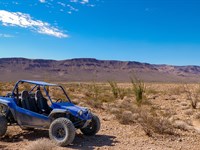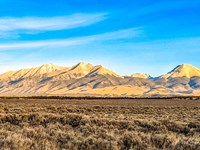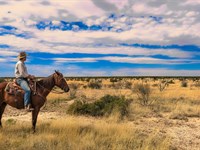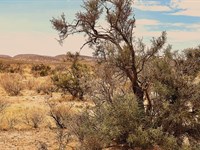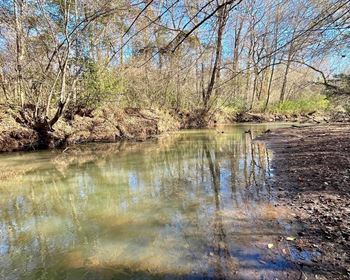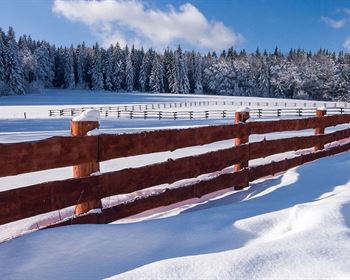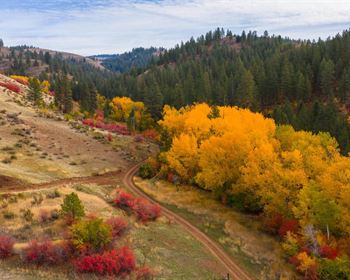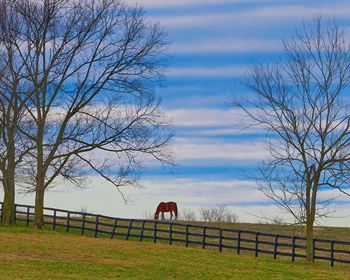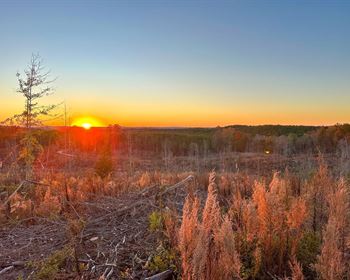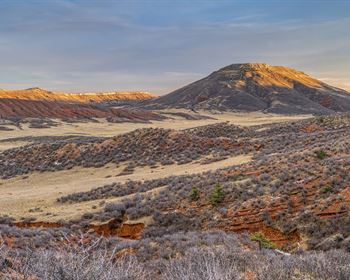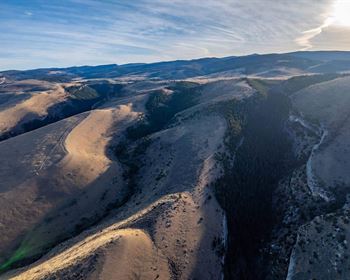Camp/Build at The Base of MT Blanca
18th St : Blanca, CO 81123
Costilla County, Colorado
Farm Description
This 5-acre property sits right on the edge of Costilla County, just a short drive from the town of Blanca. The land is open, flat, and ready for whatever you've got in mind-whether that's camping under the stars, parking your RV for a while, or planning something more permanent. It's quiet, uncrowded, and full of low brush and blooming paddle cactus, with a clear view of the Sangre de Cristo Mountains towering in the distance.
The main dirt roads are smooth and easy to handle, and while the last stretch is a little rockier, it's short and manageable. Power is close-about a mile out-and cell service holds strong, so you can stay connected even while getting away.
This is the kind of land that gives you room to think and freedom to choose. Whether you're setting up a base for hunting and hiking, building something from the ground up, or just looking for a piece of the West that's still untouched, this spot is for you. Come see it for yourself and imagine what you could do here.
We are open to owner financing as well - here is what that would look like:
- Total Money Down: $599($349 downpayment + $250 closing cost)
- Monthly: $219/Month for 45 months
See Info below.
- Subdivision: San Louis Valley Reservoir
- State: Co
- County: Costilla
- Zip:
- Size: 5 acres
- Parcel: 70355770
- Legal Description: S.L.V.R. Unit 14 Blk 12 Lot 5
- Approximate Lat/Long Coordinates:
37.5118, -105.5554
37.5118, -105.5566
37.51, -105.5566
37.5099, -105.5554
- Annual Taxes: Approximately 173.44/Year
- Zoning: Estate Residential
--- For a site built home, you need a 600sqft minimum footprint.
--- Mobile homes are Allowed.
--- You can camp for 14 days (every 3 months)
--- Temporary RV Occupancy permit available for up to 180 days if a well has been permitted or cistern installed and a septic or onsite waste management system has been installed ($250 fee - good for 60 days at a time while building, renewable).
--- Zoning office is open Monday through Thursday and can be contacted to answer any questions.
- Hoa/Poa: No
- Improvements: None
- Access: 18th St
- Water: Would be by well or holding tank
- Sewer: Would be by septic
- Utilities: Would be by Alternative
Note: Information presented on this page is deemed accurate, but is not guaranteed. Buyer is advised to do their own due diligence
Information presented in this listing is deemed accurate but is not guaranteed. Buyers are advised to conduct their own due diligence and verify all details independently.
---
Location And Setting Overview
- Blanca Proximity and Convenience: Just minutes from the historic railroad town of Blanca, your property offers the perfect balance of rural tranquility and accessible amenities. Blanca provides essential services including gas stations, a grocery store, and local dining options, all within a comfortable drive from your front door. The town's location along US Highway 160 makes it a natural hub for travelers and locals alike, ensuring you have access to supplies and services without sacrificing the remote feeling of mountain living.
- Valley Floor Elevation Benefits: At approximately 7,600 feet elevation, your property enjoys the ideal mountain climate without the extreme weather conditions of higher elevations. This positioning provides crisp, clean air and stunning views while maintaining comfortable year-round living conditions. The elevation is high enough to escape the heat and humidity of lower regions yet moderate enough for practical daily living and comfortable outdoor activities in every season.
- Access to Major Transportation Corridors: Your property benefits from excellent access to Colorado's major east-west transportation route via US Highway 160, which runs just north of your location through Blanca and Fort Garland. This highway connects you directly to the Interstate 25 corridor (70 miles east) for travel to Colorado Springs, Denver, and beyond, while westward travel takes you to Alamosa (35 miles) and eventually to Durango and the Four Corners region. The accessibility ensures you're never truly isolated while maintaining the rural lifestyle you're seeking.
- Clear Mountain Views and Open Horizons: The western valley position provides spectacular panoramic views of the Sangre de Cristo Range, including prominent peaks like Mount Blanca (14,345 feet), Colorado's fourth-highest mountain. These dramatic peaks create a stunning backdrop that changes throughout the day as light and weather patterns shift across their massive faces. The open terrain surrounding your property ensures these views remain unobstructed, giving you a front-row seat to nature's daily light show.
- Proximity to the Rio Grande Corridor: Your property sits approximately 8 miles east of the Rio Grande River, Colorado's lifeline that flows through the heart of the San Luis Valley. This proximity provides access to excellent fishing opportunities, wildlife viewing, and riparian habitat that supports diverse bird populations and large game animals. The river corridor also offers recreational activities like float trips and provides crucial water resources for the valley's agricultural heritage.
- Strategic Position for Outdoor Adventures: The western valley location serves as an ideal base camp for exploring Colorado's outdoor wonders. Great Sand Dunes National Park lies just 45 minutes north, while the Sangre de Cristo Wilderness areas are easily accessible for day trips or extended backcountry adventures. Your property's position allows you to enjoy diverse recreational opportunities without the higher costs associated with mountain resort communities.
- Weather Patterns and Climate Advantages: The western valley experiences slightly milder weather patterns than the eastern foothills, with the Sangre de Cristo Mountains providing natural windbreak protection from harsh eastern storms. The position receives excellent solar exposure throughout the day, making it ideal for solar power systems and passive solar heating designs. Average annual precipitation remains low at around 8-10 inches, mostly falling as manageable snow in winter and brief afternoon thunderstorms in summer.
- Dark Sky Benefits for Astronomy: The western valley position offers exceptional dark sky conditions with minimal light pollution from urban areas. The clear, dry air at this elevation provides outstanding visibility for stargazing and astronomy, with the Milky Way clearly visible on clear nights. Many residents find the night sky displays to be one of the most compelling features of valley living, offering a connection to the cosmos that's impossible to experience in more developed areas.
Recreational Opportunities
- World-Class Fishing Access: The San Luis Valley offers some of Colorado's most productive fishing waters within easy reach of your property. Mountain Home Reservoir, just 30 minutes north, provides excellent trout fishing with regular stocking programs and trophy fish opportunities. The reservoir's 19,500 acre-feet of clear mountain water support healthy populations of rainbow trout, brown trout, and occasional trophy fish exceeding 20 inches. Boat launches and primitive camping areas make it perfect for multi-day fishing adventures.
- Rio Grande River Adventures: The legendary Rio Grande flows just 8 miles west of your property, offering classic Western fly fishing and float trip opportunities. This historic river supports native Rio Grande cutthroat trout, rainbow trout, and brown trout populations in designated Gold Medal Waters sections. Local outfitters provide guided float trips that combine fishing with wildlife viewing and historical education about the river's role in Western settlement and agricultural development.
- Great Sand Dunes National Park Access: One of Colorado's most unique natural wonders lies just 45 minutes north of your property. Great Sand Dunes National Park features North America's tallest sand dunes, rising 750 feet above the valley floor and creating a surreal landscape that attracts over 500,000 visitors annually. Activities include sandboarding, sand sledding, photography, and seasonal Medano Creek beach experiences when snowmelt creates a natural beach at the base of the dunes.
- Mountain Access for Peak Bagging: Your western valley position provides excellent access to Colorado's famous "fourteeners" - peaks exceeding 14,000 feet elevation. The nearby Sangre de Cristo Range includes multiple accessible 14ers including Mount Blanca, Kit Carson Peak, Challenger Point, and Crestone Peak. These mountains offer climbing experiences ranging from moderate hiking to technical rock climbing, all within day-trip distance from your property base camp.
- Hunting Paradise in Game Management Unit 83: Your property sits within GMU 83, renowned throughout Colorado for exceptional big game hunting opportunities. The area supports one of the largest elk herds in the state, with the Trinchera elk herd numbering an estimated 16,000 animals. Success rates for elk hunting consistently exceed state averages, making this a premier destination for both archery and rifle hunting seasons. Mule deer populations are also excellent, with opportunities for trophy bucks.
- OHV and ATV Trail Systems: The valley's vast network of county roads and public land access points provides endless opportunities for off-highway vehicle recreation. Popular routes include the extensive trail systems in the surrounding Rio Grande National Forest, where riders can explore remote canyons, alpine meadows, and ghost town sites. Many trails connect to backcountry camping areas and provide access to hunting and fishing locations unreachable by standard vehicles.
- Photography and Wildlife Viewing: The diverse ecosystems surrounding your property create exceptional photography opportunities throughout the year. Spring wildflower displays paint the valley floor in vibrant colors, while autumn brings golden aspen forests in the nearby foothills. Wildlife photography opportunities abound with elk, deer, pronghorn antelope, and numerous bird species providing subjects for both amateur and professional photographers.
- Winter Sports and Snow Recreation: While your property sits below heavy snow zones, nearby areas offer excellent winter recreation opportunities. Wolf Creek Ski Area, famous for receiving over 430 inches of annual snowfall, lies approximately 2 hours west and provides some of Colorado's most reliable powder skiing. Cross-country skiing and snowshoeing opportunities exist throughout the valley and adjacent foothills during winter months.
- Mountain Biking Adventures: The valley's network of county roads, jeep trails, and forest service routes provides diverse mountain biking opportunities for all skill levels. Popular routes include sections of the famous Rainbow Trail system, which traverses nearly 100 miles along the Sangre de Cristo Range. Riders can enjoy everything from gentle valley floor rides with mountain views to challenging climbs into high country aspen forests and alpine meadows.
- Horseback Riding Heritage: The San Luis Valley's ranching heritage makes it ideal for horseback riding and equestrian activities. Local outfitters offer guided rides through scenic valley locations, while many residents maintain their own horses for personal recreation. The open range character and network of ranch roads provide endless riding opportunities, from leisurely evening rides to multi-day pack trips into the surrounding mountains.
- Camping and RV Recreation: Your property's zoning allows for 14 days of camping every three months without permits, making it perfect for extended family gatherings, hunting camps, or simply enjoying the outdoor lifestyle. The flat terrain and multiple building sites provide excellent locations for RV placement and camping setups. Many owners establish semi-permanent camps while planning future building projects or simply as seasonal retreats.
- Rockhounding and Mineral Collecting: The San Luis Valley and surrounding mountains have a rich geological history that provides excellent rockhounding opportunities. Areas throughout Costilla County have produced specimens of garnets, quartz crystals, and various minerals associated with the region's mining heritage. Metal detecting is permitted on private property, and many residents enjoy recreational prospecting as a connection to the area's gold rush history.
- Stargazing and Astronomy: The valley's high elevation, dry climate, and minimal light pollution create some of the darkest skies in the continental United States. Your property's location provides Bortle Scale 2-3 dark sky conditions, allowing clear views of the Milky Way, meteor showers, and deep space objects. Many residents establish observatory sites on their property and participate in regional astronomy groups and star parties.
- Water Sports and Reservoir Recreation: Several reservoirs within driving distance provide opportunities for boating, water skiing, and swimming during summer months. Sanchez Reservoir offers warm-water fishing and water sports, while Smith Reservoir provides additional fishing and camping opportunities. These water bodies create oasis-like conditions in the high desert environment and support diverse waterfowl populations during migration seasons.
Wildlife And Hunting
- Elk Hunting Excellence: Your property provides access to some of Colorado's most productive elk hunting in the famous GMU 83. The Trinchera elk herd, one of the largest in North America with an estimated 16,000 animals, migrates through this area seasonally, providing exceptional hunting opportunities. During September's archery season, bull elk bugling echoes across the valley as massive 6x6 bulls engage in rutting behavior, creating unforgettable hunting experiences that draw sportsmen from across the nation.
- Trophy Mule Deer Populations: The San Luis Valley supports outstanding mule deer populations with excellent trophy potential. Large mature bucks with impressive antler spreads inhabit the mix of agricultural fields, sagebrush flats, and foothills surrounding your property. Hunting success rates consistently exceed state averages, with many hunters harvesting quality bucks in the 150-180 Boone and Crockett class range. The combination of excellent habitat and careful wildlife management creates ideal conditions for trophy deer hunting.
- Diverse Big Game Species: Beyond elk and mule deer, the area supports healthy populations of pronghorn antelope, white-tailed deer, and black bears. Pronghorn hunting offers unique challenges as these speed demons can reach 60 mph across the open sagebrush flats. Black bear hunting opportunities exist in the foothill areas, with both spring and fall seasons providing chances at quality bears feeding on oak brush, berries, and agricultural crops.
- Upland Bird Hunting Paradise: Wild turkey populations thrive throughout the valley, with excellent spring gobbler hunting and fall either-sex seasons. These Rio Grande turkeys provide challenging hunting in diverse terrain from river bottoms to foothill oak brush. Blue grouse (dusky grouse) inhabit the higher elevations and provide exciting mountain hunting opportunities during autumn seasons.
- Waterfowl Migration Corridor: The San Luis Valley serves as a critical stopover point along the Central Flyway, with hundreds of thousands of waterfowl using the area during spring and fall migrations. Sandhill cranes create spectacular viewing opportunities as massive flocks stage in nearby wetlands, while various duck and geese species provide hunting opportunities on area reservoirs and agricultural fields during appropriate seasons.
- Predator Hunting and Calling: Coyote populations are robust throughout the valley, providing year-round hunting opportunities with no bag limits. These intelligent predators require skilled hunting techniques and calling strategies, making them popular with hunters seeking challenging quarry. Red foxes, bobcats, and occasional mountain lions add to the predator hunting opportunities for those with appropriate licenses and experience.
- Small Game Abundance: Cottontail rabbit populations thrive in the sagebrush and agricultural areas surrounding your property, providing excellent small game hunting for families and those seeking meat for the table. These rabbits support the larger predator populations while providing accessible hunting opportunities for all skill levels. Jackrabbit populations also exist in more open areas.
- Wildlife Viewing from Your Front Door: Daily wildlife viewing opportunities exist right from your property. Elk herds commonly cross valley floor areas during seasonal migrations, with groups of 50-100 animals moving between summer ranges in the mountains and winter ranges on the valley floor. These magnificent animals can often be observed during early morning and evening hours as they move through traditional travel corridors.
- Pronghorn Antelope Spectacles: North America's fastest land animals inhabit the open sagebrush country surrounding your property. These unique animals, capable of sustained speeds over 45 mph, provide incredible viewing opportunities as they bound across the landscape with their distinctive white rumps flashing. During autumn rutting season, dominant bucks establish territories and compete for breeding rights in displays of speed and agility.
- Bird of Prey Concentrations: The valley's abundant prey species support impressive populations of raptors. Golden eagles soar overhead daily, using thermal updrafts to hunt for prairie dogs and rabbits across the vast landscape. Ferruginous hawks, red-tailed hawks, and rough-legged hawks add to the raptor diversity, while great horned owls and burrowing owls provide nighttime and daylight viewing opportunities respectively.
- Seasonal Wildlife Patterns: Understanding seasonal wildlife movements enhances both hunting and viewing opportunities. Spring brings elk calving season and the beginning of antler growth cycles, while summer disperses animals into higher elevations. Fall concentrates wildlife as animals prepare for winter, creating the best hunting and viewing opportunities. Winter brings animals back to lower elevations where they can be observed from your property.
- Traditional Hunting Heritage: The San Luis Valley maintains strong hunting traditions dating back to Native American peoples and early Hispanic settlers. Modern hunting continues this heritage while supporting wildlife management and conservation through license sales and habitat improvement projects. Local knowledge passed down through generations provides valuable insights into animal behavior and successful hunting strategies.
- Game Processing and Management: The area supports local businesses specializing in game processing and taxidermy services, making it convenient for successful hunters to properly handle their harvests. Many residents develop meat processing skills for their own game, creating a self-sufficient lifestyle that connects them directly to their food sources through ethical hunting practices.
- Hunting Access and Opportunities: While your property provides a base camp for hunting activities, the surrounding area offers extensive public land access through Rio Grande National Forest, BLM lands, and walk-in hunting access programs. These opportunities ensure that hunters have abundant options for pursuing various game species without the high costs associated with private hunting preserves or guided hunts.
---
Historical Significance
- Where Colorado's Story Began: Your property sits in the heart of what Costilla County proudly calls "Where Colorado Began" - the first area in present-day Colorado to be permanently colonized by European settlers. Spanish explorers first reached this region as early as 1540 when Francisco Vásquez de Coronado's expedition passed through the area searching for the legendary Seven Cities of Gold. While they didn't find gold cities, they discovered a valley of incredible beauty and resources that would shape Colorado's future.
- Ancient Native American Heritage: For thousands of years before European contact, this land served as hunting grounds and seasonal camps for various Native American tribes, primarily the Ute people. Archaeological evidence throughout the valley indicates continuous human habitation for over 10,000 years, with arrowheads, pottery shards, and grinding stones regularly discovered by landowners and visitors. The area's abundant wildlife, water sources, and protected winter camps made it a crucial resource for nomadic tribes moving between summer mountain camps and winter valley refuges.
- Spanish Colonial Land Grant Legacy: Your property exists within the historical boundaries of the massive Sangre de Cristo Land Grant, awarded in 1844 by the Mexican government to Carlos Beaubien and Guadalupe Miranda. This grant encompassed nearly two million acres and established the legal framework for settlement that continues today. The grant system allowed settlers to farm, ranch, and use vast common areas for grazing and timber, creating a community-based approach to land use that influenced the valley's development for generations.
- Historic Settlement at San Luis: Just 20 miles southwest of your property, the town of San Luis was established in 1851 by Hispanic settlers from Taos, New Mexico, making it Colorado's oldest continuously inhabited community. These pioneering families brought traditional Spanish Colonial building techniques, agricultural methods, and cultural practices that remain visible throughout the valley today. The town's original Spanish Colonial plaza design and adobe construction methods represent an unbroken link to the area's Mexican period heritage.
- Railroad Era Transformation: The arrival of the Denver and Rio Grande Railroad in the late 1870S fundamentally changed the San Luis Valley's connection to the outside world. The narrow-gauge railroad reached nearby Blanca by 1878, creating the depot and commercial center that still serves your area today. This railroad development brought new settlers, enabled large-scale agricultural development, and connected the valley to markets in Denver and beyond, transforming it from an isolated frontier region into a productive part of Colorado's growing economy.
- Fort Garland Military Heritage: Fifteen miles northeast of your property, Fort Garland was established in 1858 as the U.S. Army's primary frontier outpost in the San Luis Valley. The fort served as headquarters for legendary frontiersman Kit Carson during his final military command from 1866-1867, when he negotiated peaceful relations with Ute tribes and protected settlers during Colorado's territorial period. Buffalo Soldiers of the 10th Cavalry were also stationed here, adding to the fort's multicultural military heritage.
- Mining History and Ghost Towns: The mountains surrounding the San Luis Valley experienced modest mining booms during Colorado's mineral rush era of the 1870S-1890S. Prospectors established small mining camps in nearby canyons, searching for gold, silver, and copper deposits. While major strikes eluded the area, remnants of mining activity can still be found in the form of abandoned mine shafts, prospect holes, and tumbledown cabins in remote mountain locations, providing interesting exploration opportunities for property owners interested in Colorado's mining heritage.
Building And Development Options
- Estate Residential Zoning Freedom: Your 5-acre property enjoys Estate Residential zoning that provides maximum flexibility for creating your ideal mountain retreat. This zoning classification was specifically designed to accommodate rural residential development while preserving the open, agricultural character that makes the San Luis Valley special. Unlike restrictive city zoning, Estate Residential encourages creative building solutions and alternative lifestyle approaches that match the independent spirit of valley residents.
- Minimum Building Requirements: Costilla County requires a minimum of 600 square feet of living space for any permanent dwelling, a reasonable threshold that accommodates everything from cozy mountain cabins to tiny house movements while ensuring basic safety and habitability standards. This minimum applies only to the main residence and doesn't include basements, porches, garages, or accessory buildings, giving you flexibility to design compact, efficient living spaces that take advantage of the area's stunning views and outdoor lifestyle opportunities.
- Manufactured Home Welcome: The county explicitly allows manufactured homes built in 1976 or later, recognizing these modern units as quality housing options that meet HUD building standards for safety and durability. This flexibility makes mountain living accessible to buyers with various budgets and construction preferences. Manufactured homes must be placed on permanent foundations with proper skirting and utility connections, ensuring they function and appear like traditional homes while offering faster, more affordable construction timelines.
- Accessory Building Opportunities: Beyond your main residence, Estate Residential zoning permits unlimited accessory structures including detached garages, workshops, barns, storage buildings, and greenhouses. Many property owners build these structures first to support construction activities and provide immediate utility while planning their main residence. These buildings don't count toward the 600-Square-Foot minimum and only require simple permits for structures over 120 square feet, making it easy to create functional homestead complexes.
- RV and Camping Flexibility: Your property offers exceptional flexibility for recreational vehicle use and camping activities. You can camp for up to 14 days every three months without any permits, perfect for extended family gatherings, hunting seasons, or simply enjoying your land while planning future development. For longer stays, Temporary RV Occupancy permits allow up to 180 days annually (renewable in 60-day increments) once you install basic utilities like a well or cistern and septic system.
- No HOA Restrictions or Fees: Unlike many subdivisions, San Luis Valley Ranches has no active homeowners association, meaning no monthly fees, architectural restrictions, or bureaucratic approvals for your building projects. You have complete freedom to choose your home's style, materials, colors, and design features without interference from neighborhood committees. This independence allows for creative architectural solutions, alternative building methods, and personalized designs that reflect your individual preferences and lifestyle needs.
- Off-Grid Building Encouragement: Costilla County actively supports off-grid living and alternative energy systems, recognizing these approaches as valid lifestyle choices rather than obstacles to development. Solar power systems, wind generators, composting toilets, and rainwater collection systems are all permitted and encouraged. The county's building department works cooperatively with owner-builders to approve alternative systems that meet safety standards while allowing maximum self-sufficiency and environmental sustainability.
- Flexible Construction Timeline: There's no requirement to build within any specific timeframe, allowing you to purchase land now and develop it when circumstances are right for your situation. Many owners hold land for years while saving for construction, planning designs, or waiting for retirement. This flexibility eliminates pressure to rush construction decisions and allows for careful planning that results in better building outcomes and more thoughtful development approaches.
- Owner-Builder Friendly Policies: The county welcomes owner-builders and provides guidance for first-time builders navigating the permit process. Planning and zoning staff maintain lists of local contractors, well drillers, septic installers, and other professionals familiar with the area's building conditions and requirements. The permitting process is streamlined for residential construction, typically taking weeks rather than months, and inspectors are willing to work with builders to ensure code compliance while maintaining flexibility for creative solutions.
- Alternative Building Methods: The county permits various alternative building approaches including adobe construction, straw bale building, earth-bermed designs, and other innovative techniques provided they meet basic safety standards. These methods often prove ideal for the area's climate conditions and can significantly reduce construction costs while creating unique, comfortable homes. Engineering documentation may be required for unusual designs, but the county maintains an open-minded approach to creative building solutions.
- Septic and Water System Options: Well installation is straightforward in the area, with most domestic wells reaching water at depths between 100-200 feet. Alternatively, cistern systems with hauled water provide viable options for those preferring lower initial costs or temporary solutions during construction. Septic system installation is routine on the area's well-draining soils, with standard systems typically costing $5,000-$8,000. The county's health department provides guidance for system sizing and placement to ensure proper function and environmental protection.
- Building Site Selection Advantages: Your 5-acre parcel provides multiple potential building sites with different orientations and views. The gently rolling terrain offers natural building locations with good drainage and protection from prevailing winds. Southern exposures maximize solar gain for passive heating and solar panel efficiency, while different sites can take advantage of sunrise views, sunset views, or panoramic mountain vistas. Multiple sites also allow for phased development with the main house, guest cabin, or workshop buildings positioned for maximum functionality and privacy.
- Utility Installation Planning: While your property is currently off-grid, electrical service is available approximately one mile away, making grid connection possible for those preferring conventional power. More commonly, owners install solar power systems that provide complete electrical independence at competitive costs. Propane delivery serves the area for heating, cooking, and hot water, while high-speed internet is available through satellite services like Starlink, ensuring modern communication capabilities in your mountain retreat.
Climate And Terrain
- High Desert Mountain Climate Perfection: At 7,600 feet elevation, your property enjoys one of Colorado's most pleasant climates, characterized by mild summers, manageable winters, and over 320 days of sunshine annually. This elevation provides the benefits of mountain living - clean air, low humidity, and comfortable temperatures - without the extreme weather conditions found at higher elevations. The high desert climate means minimal precipitation, averaging only 8-10 inches annually, creating ideal conditions for outdoor activities and construction projects.
- Four Distinct Seasons of Beauty: Each season brings unique advantages to valley living. Summer daytime temperatures rarely exceed 80°F, with cool nights dropping into the 40s that provide perfect sleeping conditions without air conditioning. Fall delivers spectacular weather with crystal-clear days, golden aspen displays in nearby foothills, and ideal conditions for outdoor projects and hunting seasons. Winter brings manageable snowfall with frequent sunny days that melt accumulation quickly, while spring arrives early with wildflower displays and perfect conditions for construction activities.
- Exceptional Solar Resources: Your property sits within one of the United States' premier solar energy regions, receiving over 320 sunny days per year with intense high-altitude solar radiation that maximizes photovoltaic system efficiency. The dry, clear atmosphere and minimal cloud cover create ideal conditions for solar power generation, making off-grid electrical systems both practical and economical. Many valley residents report their solar installations exceed expected performance ratings due to the exceptional solar resource availability.
- Gentle Rolling Terrain Advantages: The property's 3-9% slope classification provides ideal building conditions that minimize grading costs while ensuring excellent drainage. The gently rolling topography creates natural building sites with different elevations and orientations, allowing you to choose locations that maximize views, solar exposure, or privacy according to your preferences. This terrain eliminates concerns about steep slope construction challenges while providing enough elevation variation to create interesting and functional building sites.
- McGinty Fine Sandy Loam Soil Benefits: Professional soil surveys classify your property as McGinty fine sandy loam, an ideal soil type for both building construction and septic system installation. This soil composition provides excellent drainage characteristics that prevent water accumulation around foundations while offering stable support for building construction. The sandy loam composition makes excavation straightforward for basements, septic systems, and utility installations while maintaining structural integrity for long-term building performance.
- Natural Drainage and Flood Safety: The property's elevation above the valley floor and well-draining soil composition eliminate flood risks and water accumulation problems. Natural drainage patterns carry occasional precipitation away from building sites toward lower elevations, ensuring dry basements and stable foundations. Unlike many mountain properties that face drainage challenges, your location provides natural water management that simplifies construction planning and reduces long-term maintenance concerns.
- Wind Patterns and Energy Potential: The San Luis Valley experiences consistent but moderate wind patterns that provide excellent potential for small-scale wind energy generation without creating excessive weather challenges. Prevailing winds typically blow from the southwest at moderate speeds that can supplement solar power systems during cloudy periods. The valley's wide-open geography creates steady airflow patterns while surrounding mountains provide protection from extreme wind events that affect higher elevation locations.
- Precipitation Patterns and Water Planning: Annual precipitation averages 8-10 inches, with most moisture arriving as winter snow and summer afternoon thunderstorms. This low precipitation creates ideal conditions for outdoor activities and construction while requiring planning for water sources and storage. Summer thunderstorms typically develop in mid-afternoon, providing brief but intense rainfall that waters natural vegetation while clearing quickly to restore sunny conditions.
- Temperature Stability and Comfort: The high elevation moderates temperature extremes, preventing the excessive heat found at lower elevations while avoiding the bitter cold of higher mountain locations. Daily temperature variations create comfortable conditions - warm enough for outdoor activities during the day, cool enough for comfortable sleeping at night. The dry atmosphere makes both warm and cool temperatures feel more comfortable than similar temperatures in humid climates.
- Wildfire Risk Management: While wildfire is a natural part of the Western ecosystem, your property's valley floor location and sparse vegetation reduce fire risks compared to heavily forested mountain properties. The open terrain provides natural firebreaks, and the property's accessible location ensures good emergency response capabilities. Creating defensible space around buildings and using fire-resistant materials can minimize risks while maintaining the natural landscape character.
- Geological Stability and Construction: The property sits on stable Valley Fill geological formations deposited over millions of years, creating excellent conditions for construction with minimal seismic activity or geological instability. This ancient geological foundation provides reliable support for any size building project while eliminating concerns about landslides, rockfall, or unstable soil conditions that affect some mountain properties.
- Microclimate Variations: Different areas of your 5-acre property may experience slight microclimate variations based on elevation, slope exposure, and natural wind protection. These variations allow you to create different use areas - perhaps a protected garden area, an exposed solar installation site, or sheltered building locations. Understanding these microclimates helps optimize building placement, landscaping decisions, and outdoor activity areas for maximum comfort and functionality.
- Weather Predictability and Planning: The valley's weather patterns are generally predictable, with most precipitation falling during specific seasons and temperature patterns following reliable annual cycles. This predictability helps with construction scheduling, outdoor activity planning, and agricultural timing. The area rarely experiences severe weather events like tornadoes or extreme storms, making it one of Colorado's most weather-stable regions for year-round living and outdoor recreation.
- Air Quality and Atmospheric Clarity: The high elevation, distance from urban pollution sources, and frequent wind circulation create exceptional air quality that enhances both health and outdoor visibility. The clear atmosphere provides stunning photography conditions and enhances the spectacular mountain views that make this location so appealing. Many residents report improved respiratory health and energy levels after moving to the valley's clean air environment.
---
Off-Grid Living Potential
- Solar Power Paradise: Your property sits within one of North America's premier solar energy regions, where over 320 sunny days annually and intense high-altitude solar radiation create ideal conditions for photovoltaic power generation. The valley's exceptional solar resource means even modest solar installations often exceed manufacturer performance ratings, making complete electrical independence both practical and economical. Many residents report their solar systems generate surplus power even during winter months, eliminating electric bills while providing reliable, clean energy for modern conveniences.
- Well Water Independence: Domestic well drilling in your area typically reaches quality groundwater at depths between 100-200 feet, providing abundant clean water for household use, gardens, and livestock. The valley's ancient aquifer system has supported agricultural and residential use for over 150 years, demonstrating long-term sustainability and reliability. Well water quality is typically excellent, requiring minimal treatment, and domestic well permits are readily available from the Colorado Division of Water Resources for residential use including household needs, garden irrigation, and watering small numbers of livestock.
- Alternative Water Solutions: For those preferring lower initial costs or temporary solutions during construction, cistern systems provide viable water independence. A typical 1,500-2,000 gallon storage system can supply a household for several weeks, with water delivered by truck or hauled in portable tanks. Many residents start with cistern systems and later install wells, while others find hauled water perfectly adequate for their usage patterns. The county supports both approaches and provides guidance for proper installation and management.
- Septic System Advantages: Your property's McGinty fine sandy loam soil provides ideal conditions for conventional septic systems, with excellent drainage characteristics that ensure proper effluent disposal and system longevity. Standard septic installations typically cost $5,000-$8,000 and, once installed, provide decades of trouble-free waste management with minimal maintenance requirements. The county's health department assists with system design and permitting, ensuring installations meet health standards while accommodating individual property characteristics.
- Propane and Alternative Fuels: Propane delivery serves the entire San Luis Valley, providing clean-burning fuel for heating, cooking, hot water, and refrigeration. Many off-grid residents rely entirely on propane for thermal energy needs, appreciating its reliability, efficiency, and clean combustion characteristics. Wood heating remains popular using dead timber from nearby forests, while some residents experiment with solar heating systems, geothermal applications, and other renewable thermal energy approaches.
- Communication and Internet Freedom: Modern satellite internet services, particularly Starlink, provide high-speed broadband connectivity that rivals urban internet service. This technology eliminates the traditional isolation of off-grid living, allowing remote work, online education, streaming entertainment, and global communication from your mountain retreat. Cellular coverage is good throughout the valley, providing reliable phone service and backup internet through mobile hotspots when needed.
- Food Production and Self-Sufficiency: The valley's 100-120 day growing season supports productive gardens, while greenhouse operations extend food production year-round. Many residents maintain small livestock operations including chickens for eggs, goats for milk, and larger livestock for meat production. The combination of garden produce, livestock products, and nearby hunting and fishing opportunities enables significant food self-sufficiency for families committed to reducing dependence on commercial food systems.
- Energy Storage and Backup Systems: Modern battery technology, particularly lithium-ion systems, provides reliable energy storage for solar installations, ensuring power availability during cloudy periods and nighttime hours. Many installations include backup generators fueled by propane or gasoline for extended cloudy periods or high-demand situations. The combination of solar generation, battery storage, and backup generation creates extremely reliable electrical systems that often exceed grid reliability in remote areas.
- Waste Management Independence: Beyond septic systems for blackwater, composting systems can handle organic waste while reducing environmental impact. Many residents maintain compost systems for garden waste and food scraps, creating valuable soil amendments while reducing waste streams. Greywater systems can irrigate landscaping and gardens where permitted, maximizing water efficiency and creating closed-loop resource management systems.
- Transportation and Equipment: Off-grid living often requires different transportation and equipment needs, from four-wheel-drive vehicles for accessing remote areas to tractors and utility vehicles for property maintenance. The valley's dealer network provides sales and service for equipment commonly used in rural living, while the area's mechanical expertise includes professionals familiar with solar systems, generators, pumps, and other off-grid equipment.
- Community Knowledge and Support: The valley's established off-grid community provides valuable knowledge sharing and mutual support for those new to self-sufficient living. Experienced residents often share expertise in solar system maintenance, water system management, food preservation, and other skills essential for successful off-grid living. This community support network helps newcomers avoid common mistakes while building the skills necessary for long-term success in off-grid lifestyles.
Seasonal Activities
- Spring Awakening and Building Season: Spring brings renewed energy to the San Luis Valley as wildflowers paint the landscape in brilliant colors and construction season begins in earnest. March through May offers perfect weather for outdoor projects, with mild temperatures, minimal precipitation, and long daylight hours ideal for building, landscaping, and property improvements. This is prime time for well drilling, septic installation, and major construction projects while wildlife viewing peaks as migrating animals return to summer ranges and breeding activities begin.
- Summer Recreation Paradise: Summer transforms your property into the perfect base camp for Colorado's outdoor adventures, with comfortable daytime temperatures in the 70s and cool evenings perfect for campfires and stargazing. The season offers endless recreational opportunities from fishing at nearby Mountain Home Reservoir to exploring Great Sand Dunes National Park, while your property provides the ideal retreat location for family gatherings, camping adventures, and outdoor entertaining under the valley's incredibly clear skies.
- Autumn Hunting and Harvest Season: Fall brings the valley's most exciting season as hunting seasons open and autumn colors paint the surrounding foothills in gold and crimson. Your property becomes hunting headquarters for pursuing elk, deer, and other game species in some of Colorado's most productive hunting units, while the moderate weather provides perfect conditions for outdoor activities and agricultural harvest. This season showcases the area at its most beautiful, with crystal-clear air, comfortable temperatures, and spectacular mountain vistas enhanced by autumn lighting.
- Winter Solitude and Planning: Winter offers a different kind of beauty as snow dusts the peaks and occasional storms blanket the valley in peaceful white, creating ideal conditions for planning next year's projects and enjoying the solitude that draws many to mountain living. While outdoor activities continue with cross-country skiing, snowshoeing, and winter wildlife viewing, the season also provides perfect indoor time for research, planning, and preparation for spring construction activities.
- Year-Round Stargazing Excellence: Your property's exceptional dark sky conditions provide world-class astronomy opportunities throughout the year, with different seasons offering unique celestial viewing experiences. Winter's long nights showcase brilliant star fields and meteor showers, while summer provides comfortable outdoor viewing of the Milky Way and planetary alignments. The valley's minimal light pollution and clear, dry air create viewing conditions that rival professional observatory sites, making astronomy a year-round recreational activity.
- Seasonal Wildlife Spectacles: Each season brings unique wildlife viewing opportunities, from spring elk calving and bird migrations to summer wildlife photography and fall rutting displays. Winter concentrates wildlife at lower elevations where they can be observed from your property, while spring dispersal provides opportunities to witness animal behavior cycles and seasonal adaptations. Your property's position within major wildlife corridors ensures year-round viewing opportunities that connect you intimately with Colorado's natural cycles.
- Agricultural and Gardening Seasons: The valley's growing season supports productive gardens and small-scale agricultural activities that connect residents to their food sources while reducing living costs. Spring planting, summer cultivation, and fall harvest create satisfying seasonal cycles that many find rewarding after urban living experiences. Greenhouse operations extend growing seasons while livestock operations provide year-round agricultural activities for those interested in sustainable, self-sufficient lifestyles.
- Community Events and Celebrations: Throughout the year, local communities host festivals, celebrations, and cultural events that welcome newcomers while preserving traditional heritage. From spring planting celebrations to autumn harvest festivals and winter holiday observances, these community gatherings provide social opportunities and cultural enrichment that enhance rural living experiences. Participation in these events helps new residents integrate into local communities while supporting traditional practices and values.
- Your Mountain Dreams Start Here: This exceptional 5-acre property represents far more than a real estate investment - it's your gateway to the Colorado mountain lifestyle you've always imagined. Here, you can build the home of your dreams surrounded by some of the most spectacular scenery in North America, while enjoying the freedom and independence that drew pioneers to the American West over 150 years ago. Whether you envision a simple cabin retreat, an elaborate mountain estate, or an off-grid homestead, this property provides the foundation for creating the life you truly want.
- Take Action Today: Exceptional properties in Colorado's mountain regions don't remain available indefinitely. This San Luis Valley location combines affordability with spectacular mountain views, recreational access, and development potential in ways that become increasingly rare as Colorado grows and changes. Your Colorado mountain dreams don't have to remain dreams - they can become reality through one decisive action that positions you for years of mountain living enjoyment and long-term financial benefits.
The details provided in this property listing are believed to be reliable but are not warranted. Prospective buyers should perform their own research and verification of all information before making purchase decisions.
Farm Maps & Attachments
Directions to Farm
From Blanca, head west toward Smith Ave, then turn left onto Smith Ave (0.2 miles).
Turn right onto US-160 W/Main St/E US Hwy 160 and continue for 4.2 miles.
Turn right onto Vine Ave for 1.7 miles.
Turn right onto Grant Ave for 1.6 miles.
Turn right onto 18th St and continue for 0.1 miles to the property.
RetryClaude can make mistakes. Please double-check responses.
